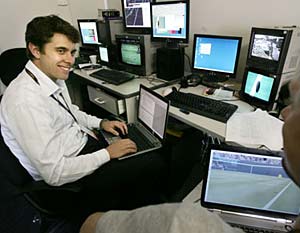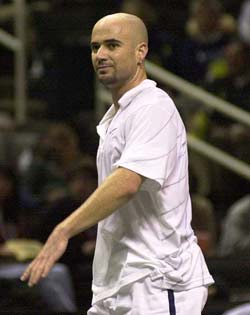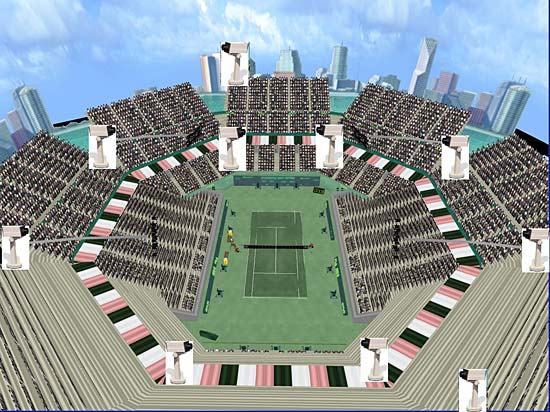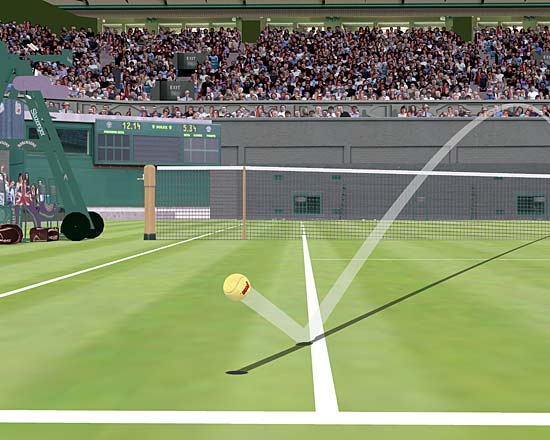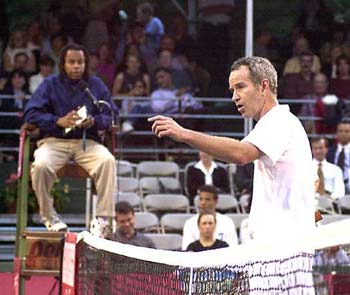|
TennisOne Lessons Why Player Challenges are a Bad Call Paul Fein and Christopher Noble “It’s not a question of the technology. It’s about how smart you are about using the capabilities.” — Charles Lurio, space exploration historian
Paul Hawkins, the British inventor of the revolutionary Hawk-Eye electronic line-calling technology, echoed those telling words in The Times when he advised the ATP and WTA Tours: “You’ve chosen this route, now just be careful how you use it.” Nearly 26 years after an electronic eye was introduced at Wimbledon for service calls, Hawk-Eye made its eagerly awaited debut at the Nasdaq-100 Open on March 22. Hawk-Eye’s precision, reliability, and speed drew rave reviews. One wonders why Pro Tennis waited so long: studies have confirmed that the human eye cannot accurately and consistently tell whether typical pro shots, let alone Andy Roddick’s 155-mph-record serve and Joachim Johansson’s 109-mph forehand, land barely on or outside the lines. That fact, which television viewers have witnessed with instant replay for years, was confirmed again at Nasdaq when 33 percent of the line calls (53 of 161) that were challenged by players were overruled. Unless technology comes to the officiating rescue, as it has in so many other sports, pro tennis will tarnish its integrity and lose its credibility. Thus the nearly unanimous consensus: the devil may be in the details, but there is no turning back. Those devilish details, though, stirred up a hornet’s nest of controversy during the Nasdaq-100.
“In my 20 years in professional tennis, this is one of the most exciting things to happen for players, fans and television viewers,” enthused Andre Agassi. Fiercely opposing the innovation, Marat Safin told the Orange County Register: “I am totally against it. I think it will destroy the game. It will slow it down, lose the momentum and the motion of the game. Who was this genius who came up with this stupid idea? Who approved it? They are looking for solutions on how to save the game, and this is not it.” Most of the controversy, however, is not about the Hawk-Eye system itself. Electronic line calls are to be used according to a new set of rules, jointly proposed by the USTA, ATP and WTA, and innocuously called the “player challenge system.” According to this system, Player Challenges to line calls would need to follow six rules:
Let’s analyze Player Challenges with the most valid criteria and determine how they measure up. FAIRNESS — Without fairness, the sine qua non of all pro sports rules, all the other criteria mean nothing. Fairness, in the officiating of tennis line calls, indisputably means getting them right as often as possible. With Hawk-Eye, that now happens a near-perfect 99.9 percent of the time. This should virtually eliminate incorrect line calls that have influenced the outcome of some matches. Who can forget distraught Serena Williams being victimized by egregious human errors and ultimately beaten by Jennifer Capriati in the 2004 U.S. Open quarters? Pro tennis is blessed—or burdened?—with an abundance of close and often controversial line calls, occasionally as many as two in a given point. Therefore, any rules that result in incorrect line calls not only are terribly unfair to the players but also a bad reflection on the sport of pro tennis. Nothing justifies incorrect line calls when Hawk-Eye can be used.
PLAYER FALLABILITY — Ironically, just when instant replay ensures that players won’t have to worry about bad line calls, Player Challenges involve them more, not less, in calling the lines. Imagine if 100-meter sprinters were instructed before the race: “OK guys, good luck, run as fast as you can, but do us a favor. We’d like you to figure out which one of you beats the others, if it’s really close.” There would be mutiny on the track. Similarly, professional tennis players in world-class tournaments should not be responsible for calling the lines in any fashion, including challenges. High-speed photography analysis, conducted separately by Vic Braden and John Van Auken, revealed that players call the shot correctly much less often than experienced linespeople, and for a host of reasons. Why? First, players have considerable visual problems because in singles the sidelines and center service lines are the only lines they are ever lined up with—with rare exceptions—and even there, seldom exactly. Second, because players are moving, and often rapidly, their visual acuity is hampered by the parallax factor: an apparent change in the direction of an object, caused by a change in the viewer’s position that provides a new line of sight. Third, the net sometimes blocks their vision. Fourth, the sheer distance is far too great for accurate calls when, for example, a player on his baseline tries to judge a ball landing 78 feet away on the other baseline. Fifth, the player’s primary focus is fixed on the entire flight of the ball so that he can hit it effectively—rather than a small spot where it very briefly (3 milliseconds) lands.
Besides all these disqualifying factors, highly motivated pro athletes are typically far from objective during the heat of battle. Yes, they insist they want, even demand, fairness, but they typically are fighting for their rights, not those of their foes. If truth be told, they fervently want all close calls adjudicated in their favor, especially on crucial points. Tennis rules should accommodate this normal behavior, not exploit it in ways that distort the outcome and then blame the athlete for the result. Let the players focus on playing great tennis! NO PLACE FOR GIMMICKS — Even if players should call lines, which they shouldn’t, and even if they could call lines accurately, which they can’t, player challenges are game-show gimmicks that don’t exist in any other pro sport and don’t belong in pro tennis either. Here’s why: At the Nasdaq-100 Open, players challenged some line calls when they clearly should not have—because they had a challenge or two left to use near the end of a set, or they were honestly mistaken by a wide margin, or merely being frivolous. Equally silly is the spectacle of players glancing over to their entourages for advice on whether or not to challenge, which is a violation of the no-coaching rule. Far worse, though, players sometimes did not challenge when they should have—because they were honestly mistaken, or rather pathetically, because they had no challenges left
“What happens if you use the challenges up? And it’s the U.S. Open final,” TV analyst Mary Carillo rightly stresses. “And there’s an incorrect call, and you have no more challenges. And if all the fans are yelling, ‘Challenge! Challenge!’ and you can’t.” Carillo calls that “the doomsday scenario” that she doesn’t want to be around to witness. “Twenty-four thousand New Yorkers, just like me, are going to have lanterns and pitchforks, screaming, “What do you mean you can’t correct the call?!? What do you mean the wrong guy wins?!?” ENTERTAINMENT — “If we are really going to grow the sport, we will do what is best for television,” averred Arlen Kantarian, USTA chief executive of professional tennis and a fervent advocate of instant replay and player challenges, in Street & Smith’s SportsBusiness Journal. Like the immortal General Motors saying, Kantarian’s credo could be paraphrased as “What’s best for television is what’s best for tennis.” And since television is the greatest vehicle for entertainment in human history, his conclusion is that Player Challenges, even though they are distracting and result in inaccurate and thus unfair line calls, should win the day. However, as Carillo rightly argues, “The powers that be at the networks don’t trust that the sport is compelling enough. They’ll do anything to trick it up because they don’t understand and appreciate its beauty, its subtleties, its very nature. And please, no gimmickry. If you so believe in the need for electronic line calls, extend that logic and use it all the time.” THE HUMAN ELEMENT — The crux of Kantarian’s entertainment thesis is the proverbial “human element.” But what exactly does “the human element” mean? It includes anything from player banter with spectators to emotional meltdowns to displays of exuberance to mild protests to raging, profane altercations between players and officials. Some aficionados relish that conflict; others find it disgusting and distracting; while most of us like it as long as it’s not too raucous and time-consuming.
The end of line-calling rhubarbs, though, won’t result in the death of the human element in tennis by any means. Disputes will always arise over rule infractions, such as foot-faults, double bounces, touching and crossing over the net, illegal coaching, etc. And wherever fiercely competitive players give their all for fame, fortune, titles and pride, they’ll glare, swear and trash talk. They’ll smash and throw racquets. They’ll stall, fake injuries, and bend and break rules, such as when Nicolas Kiefer tossed his racquet to distract Sebastien Grosjean during their contentious 2006 Australian Open quarterfinal. The human element and the excessive attention paid to officiating in a sport with an extraordinary imbalance of 13 officials for only two or four players was perceptively noted by Tennis Week publisher and former world No. 11 Gene Scott, just before his recent death. “The human element should be the two players on the court, not the officials,” Scott told FOXSports.com. “The best officials are the ones you never notice. The nature of the game made officials too noticeable a part.” THE SOLUTION — Keep Hawk-Eye, instant replay, and the indispensable linespeople. Get rid of unfair and gimmicky Player Challenges. Armed with a court-side computer monitor displaying Hawk-Eye’s results, the chair umpire could immediately overrule errors by linespeople and click a button that instantly puts Hawk-Eye’s image of the correct call on the stadium video board. When a line call is correct but a player protests—in the traditional manner—the umpire also displays Hawk-Eye on the video board. If tennis fans yearn for even more Hawk-Eye, tournaments could display it whenever balls land within 3 (or 4 or 5) inches of the outer edge of the lines. Used smartly as a means for accurate line-calling, Hawk-Eye will improve our sport. Misused alongside Player Challenges, Hawk-Eye will give tennis a black eye. Your comments are welcome. Let us know what you think about Paul Fein and Christopher Noble's article by emailing us here at TennisOne.
Paul Fein Award-winning tennis writer Paul Fein's book, Tennis Confidential: Today's Greatest Players, Matches, and Controversies , published by Brassey's, Inc., was listed No. 1 among tennis books by Amazon.com and BN.com. Information about the book and how to order it can be found at: www.tennisconfidential.com . His second book, You Can Quote Me on That: Greatest Tennis Quips, Insights, and Zingers , was published by Potomac Books, Inc. (formerly Brassey's, Inc.) in February 2005. For more information, visit www.tennisquotes.com Christopher Noble Christopher Noble is a founder and the CEO of Ultimate Balance, Inc. ( www.ultimatebalance.com), a technology company that is applying electronic motion sensing and audio feedback to athlete training in tennis and other sports. He has had a 27-year career in the development and application of technology to a wide range of consumer and industrial applications. |

